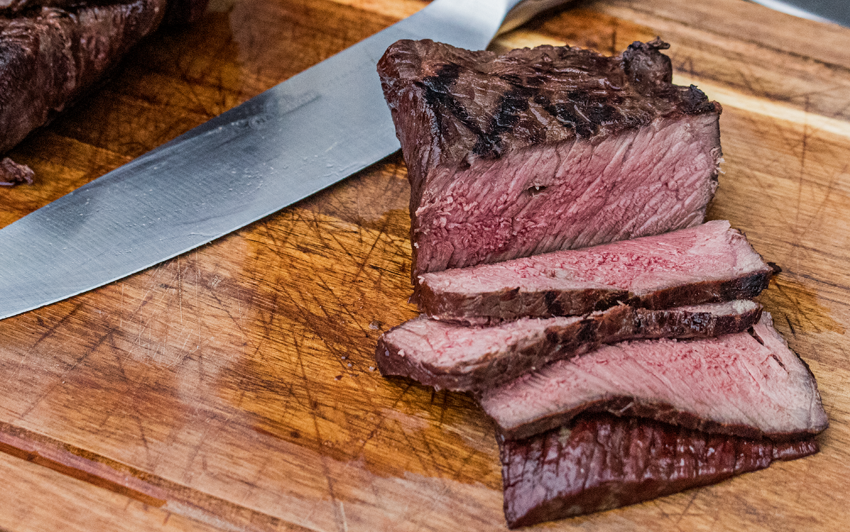
The Science of BBQ - White Meat Vs. Red Meat
While exploring the science of barbecue we’ve explored everything from cooking and how that happens to how smoking works, and even about the wonders of salt. In this article, let us explore the differences between white or light meat when compared to red or dark meat. The age-old white meat vs. red meat discussion is very interesting when you break it down into the makeup of these muscle groups and what they are used for.
Try the recipe from our feature image, Oak Smoked Tri Tip.
Red Meat
Red meat is considered any meat from mammals that fall into the livestock category and features higher concentrations of myoglobin that create the telltale red hue. This category includes beef, lamb, pork, goat, and farmed game like venison, elk, and bison.
While pork is a lot lighter in pigment than cattle, they are, in fact, red meat. They spend their days standing and walking. Most pork that is purchased is young and small, so there is little myoglobin development. The larger the cut and older the animal, the darker in color the meat can be.
You need to eat this delicious Jalapeno Popper Pork Loin recipe.
Dark Meat
Dark meat also contains larger concentrations of myoglobin, hence the deeper color in meats like chicken and turkey. Poultry that are wilder and more active, like ducks and geese, are made up of all dark meat because all of their muscles are filled with myoglobin for endurance.
Slow Twitch Muscles
Groups of muscle that are used for long stretches of regular activity like standing and walking are called slow twitch muscles. These muscles are made for stamina and endurance and are constantly working. These groupings contain high quantities of myoglobin which is constantly feeding these muscles so they can be used. Slow twitch groups of muscles usually contain more marbling as these muscles can burn fat to gain more energy. Slow twitch muscles are denser and will take longer to cook.
Featuring both white and dark meat, roast turkey has the best of both worlds. Try it yourself in this delicious Spatchcocked Turkey recipe.
Myoglobin carries the oxygen from blood into muscles. It is red because of the iron contained within and only looks red when oxygen is bound to it. When the process of cooking that myoglobin will begin to degrade, especially over temperatures of 140°F/60°C. This is why red meats that are cooked above these temperatures will become grey/brown and don’t become red when exposed to air, like a perfectly medium-rare steak would. This is why it is important to never cook your steak past medium.
Light/White Meat
This is typically thought of as poultry meat found in the breast area, characterized by the lack of red coloring. Pork is not white meat, even if it is a much lighter color than most red meats.
Most of the poultry that you purchase will feature both white and dark meat when purchasing whole birds or you will have to select between white or dark meat cuts like breasts or thighs. The muscles in each type of group are of different densities and require different cooking times. This is why you may find your breast meat dries out before the thigh and legs are cooked when roasting a whole bird.
Fast Twitch Muscles
Fast twitch muscle groups have less endurance and are used for short bursts of movement or small precise movements as they tire easily. These muscles lay at rest until they are needed. Fast twitch muscle groups use glycogen, a carbohydrate, for fuel instead of myoglobin. This is why there is far less pigmentation. These groups also do not contain a lot of intramuscular fat or marbling because they cannot utilize fat to create energy. Fast twitch muscles are less dense than their hardworking, slow twitch, counterparts. This makes them more tender when cooked to perfection.
Featuring a fast twitch muscle, the beef tenderloin is no less succulent for eating. Try this recipe for a delicious Tenderloin au Poivre and see what we mean.
What Does This Mean for the Meat you Eat?
Meat has a texture that is directly related to its function, the size of the bundles of muscle fiber as well as the surrounding connective tissues determine this texture. Small bundles and thin connective tissue has a finer texture than larger groupings which have more connective tissue. This also indicates what the muscle was used for. Precision and fast movements, in the case of tenderloin or breast, vs the coarse texture of larger, well-used muscles, like the shoulder or brisket, are heavy-working muscles.
The process of rendering the fat in connective tissues has a decided effect on the texture of your meal. The melted fat and collagen (that becomes gelatin when cooked) combine with the meat to lubricate the fibers as they are chewed creating succulence in your mouth. And let us not forget that there is a huge correlation between fat and flavour. Lean meat from an animal will take on the flavor of the animal the fat is added from. Pig fat with lean chicken or beef will produce a taste that is distinctly porky.
Now that you know what the difference between white and red meat is and how that can change things when grilling, what will you cook next? Tell us what you thought about The Science of Barbecue: White Meat Vs. Red Meat and your cooking adventures on your barbecue. Share your favorite recipes, success stories, and photos with us on our social pages like Instagram and Facebook. Don’t forget to use the hashtags #NapoleonEats and #NapoleonGrill!



